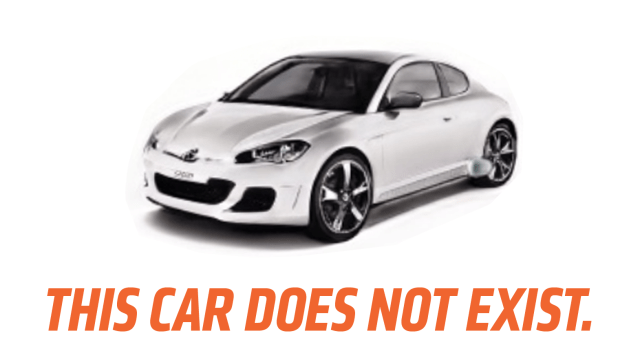There’s been a lot of coverage in the news lately about the results a group of researchers at NVIDIA have been getting with advanced Artificial Intelligence (AI) algorithms that have been used to generate alarmingly naturalistic-looking human faces. The faces are very impressive and suggest a lot of complicated possibilities, but what no one is addressing yet is that these same AI routines have been generating some truly bonkers but oddly plausible-looking hypothetical cars. You’d better take a look at these.
The NVIDIA team released a paper describing their work this week, and it’s fascinating and not really comprehensible to people not keeping up with the rapid advances in AI. The team has been using generative adversarial networks (GAN) and has been training these networks with large pools of sample images.
They’re also using a technique known as style mixing, which is sort of taking the general visual “look” of something and applying it to something else. With maths and stuff.
Here’s the abstract of the paper:
We propose an alternative generator architecture for generative adversarial networks, borrowing from style transfer literature. The new architecture leads to an automatically learned, unsupervised separation of high-level attributes (e.g., pose and identity when trained on human faces) and stochastic variation in the generated images (e.g., freckles, hair), and it enables intuitive, scale-specific control of the synthesis. The new generator improves the state-of-the-art in terms of traditional distribution quality metrics, leads to demonstrably better interpolation properties, and also better disentangles the latent factors of variation. To quantify interpolation quality and disentanglement, we propose two new, automated methods that are applicable to any generator architecture. Finally, we introduce a new, highly varied and high-quality dataset of human faces.
Got all that? Here’s the definition of stochastic for you, to save you some time.
Here’s a sample of the artificially-generated faces this thing can produce:
Those are not real, actual faces, remember. Whoa, right?
They also used datasets of interior bedrooms, cats, and cars to generate artificial images, but we’re interested in the cars, of course. Here’s some of the resulting artificial car images they provided in the paper:
Fascinating! These all certainly look like cars, some more plausible than others. It’s worth noting that cars are a bit less forgiving than human faces, likely because they’re not biological things, with all the flexibility and inherent variation that’s natural to biomorphic images. I think that’s why some of the cars look weirder than the faces—cars are things with a more demanding precision, visually.
Also, it doesn’t seem that the AI was told to necessarily force symmetry, which is why some of these look especially odd. Let’s take a look at some interesting ones:
This one feels like a half-assed Chrysler 300 competitor. Maybe from SsangYong or something.
This one is missing an indicator, but I like it. It feels like a low-volume American sports car. Maybe built by Panoz. Possibly mid-engined?
This looks really plausible to me. Like if Renault and Daihatsu collaborated on a sports coupe for the European market.
For some reason, this one feels really British to me. Like a prototype AWD luxury fastback sedan Rover was developing to sell in America under the Sterling brand. The front end looks a bit like it’s got some kind of integrated brush guards or something.
Look at that mutated Beetle-thing! And that very normal-looking red car that reminds me of a late ‘70s Datsun! And the novel proportions on the blue and silver cars! And that white-and-red drift-car-looking thing!
Some cars ended up looking so probable they’re almost boring:
…while others veer into the tragic:
I’m not sure what’s going on with that elephantine wheel, and it also appears that the algorithm doesn’t have enough data to render a composite engine, but it made a decent go of it. It looks like, on that yellow vintage-ish car there, that it attempted to generate a grille badge on the exposed radiator.
And that Porsche 911/Nissan GTR mutant has seen better days.
At their worst, these AI-generated cars remind me of those failed Ripley/Alien hybrids in those tanks from Alien: Ressurection. See what I mean:
But, when they get it right, the results are shockingly impressive. I think we’re nearing a point where focus groups could design a particular car by feeding some design AI a huge batch of related images.
That’s kind of an alarming thought.
